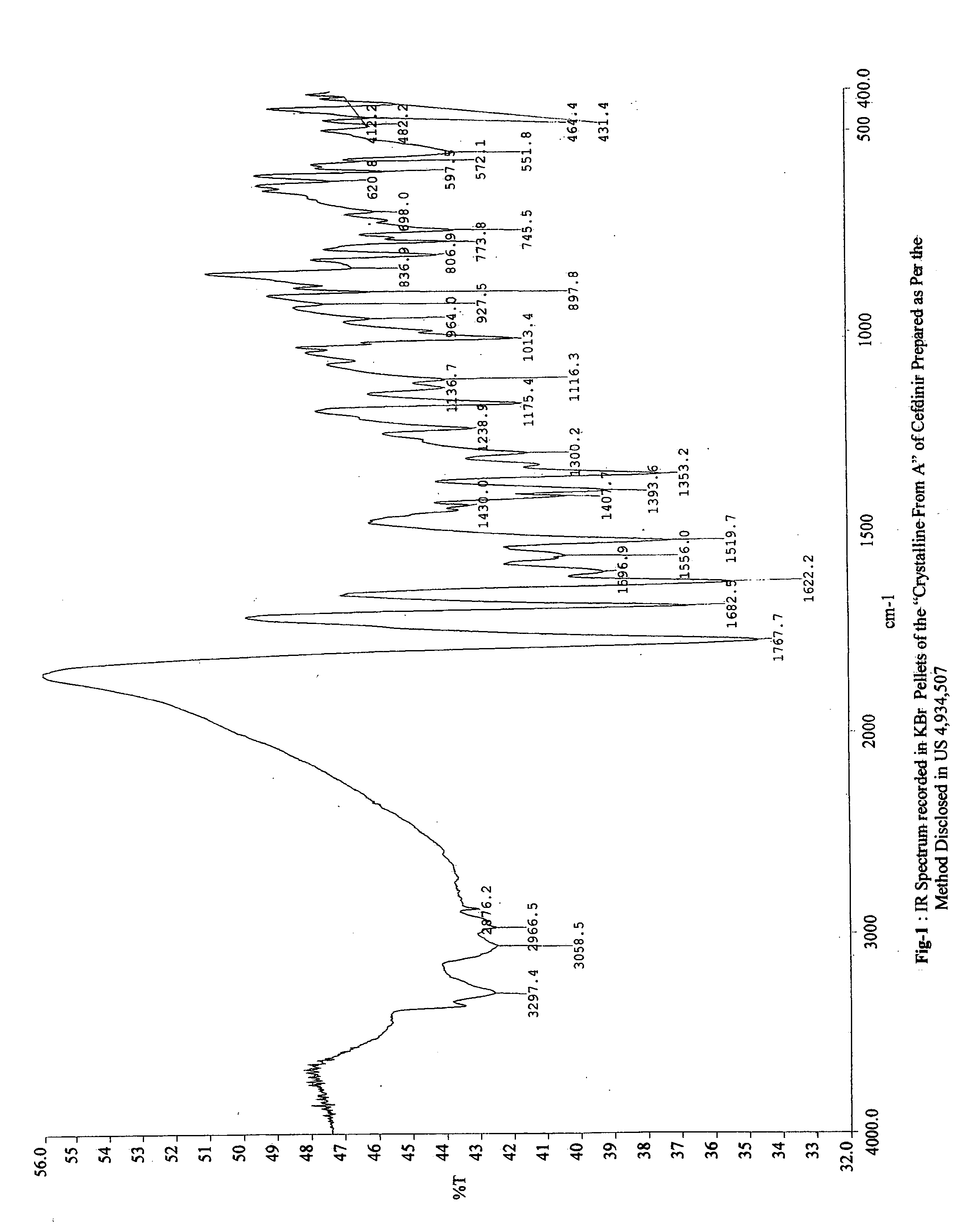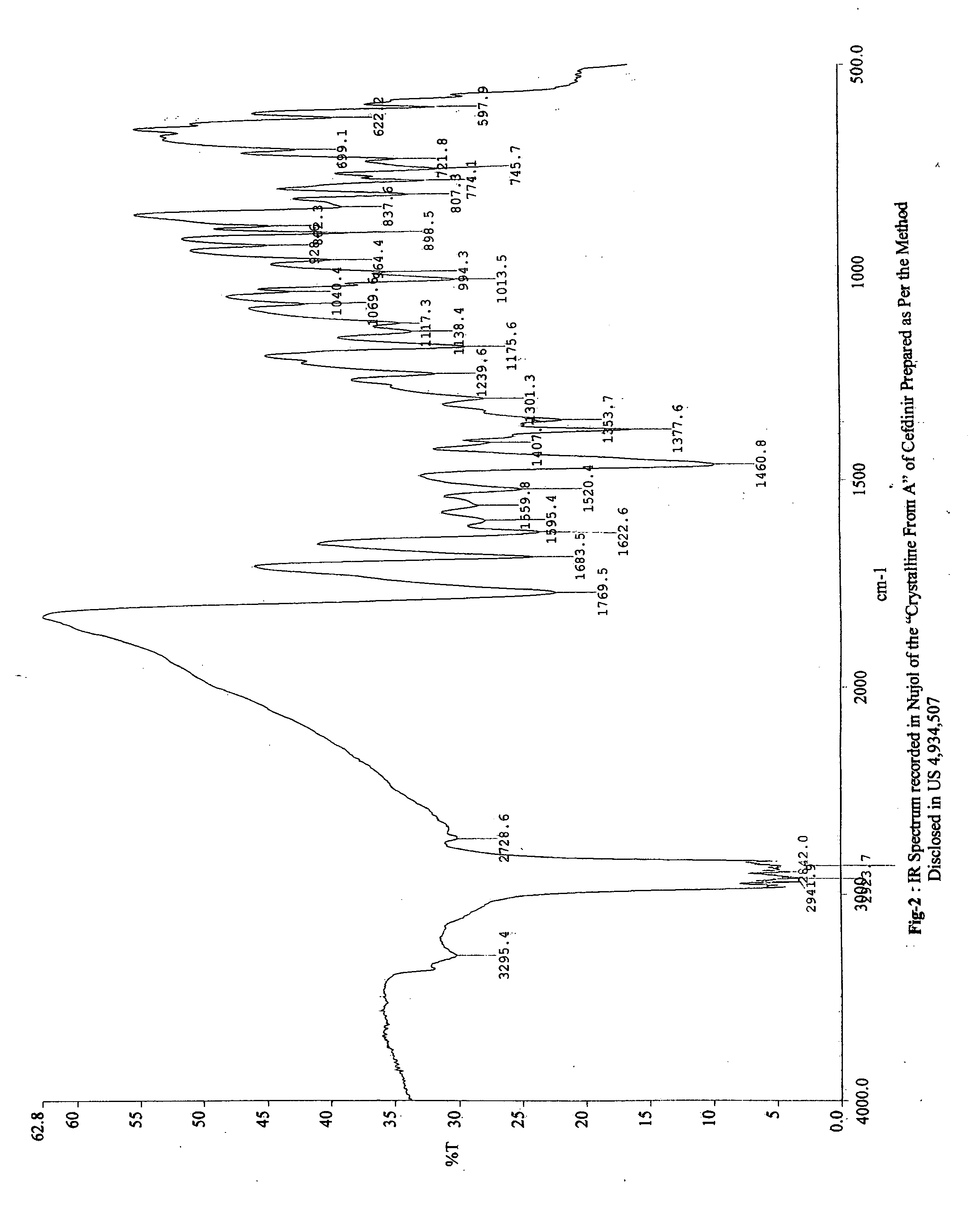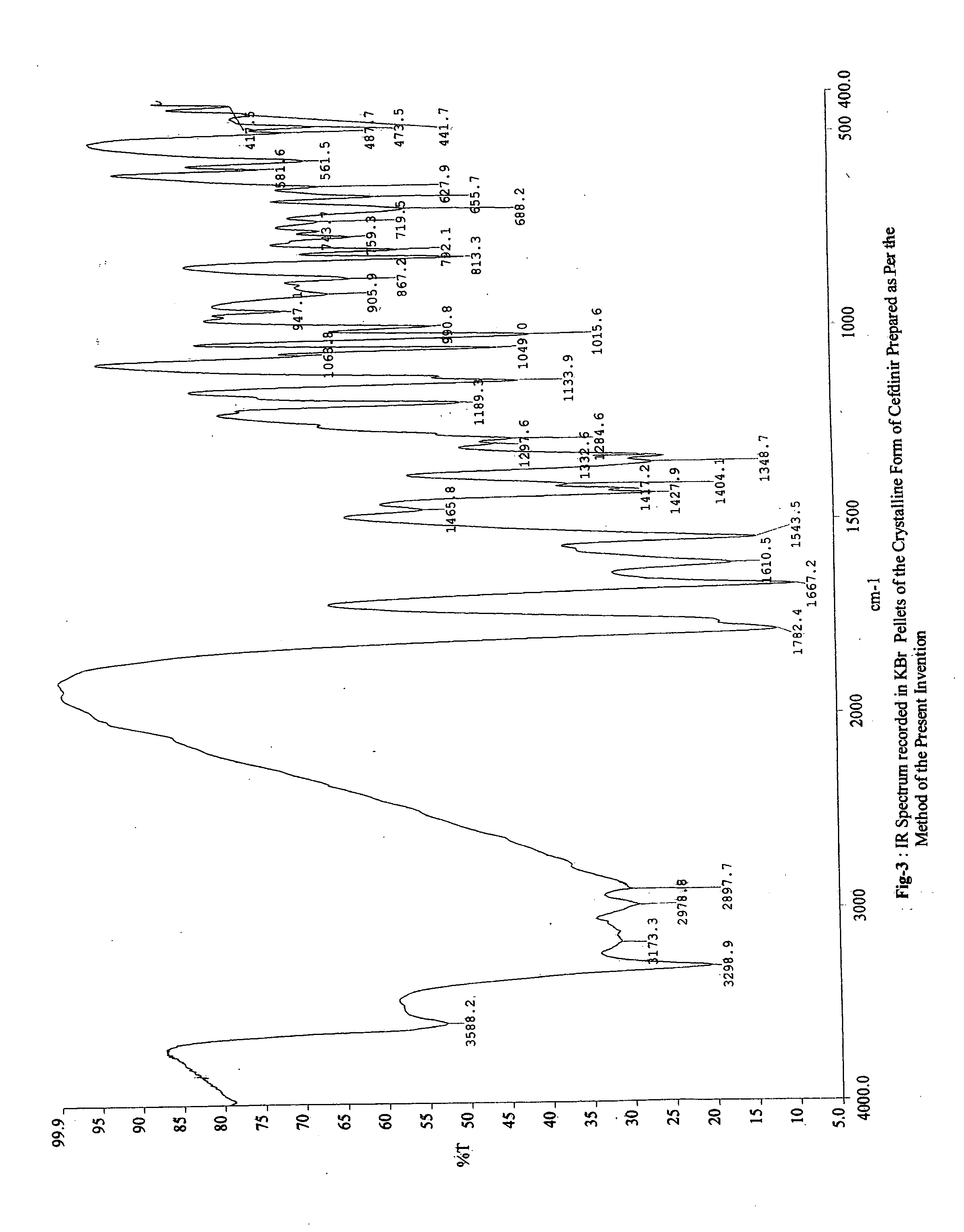Stable bioavailable crystalline form or cefdinir and a process for the preparation thereof
a bioavailable, crystalline form technology, applied in the direction of organic active ingredients, pharmaceutical active ingredients, organic chemistry, etc., can solve the problems of solvents posing serious hazards in the operationability of the process, not only difficult to remove, and difficult storage, so as to achieve high stability and bioavailable
- Summary
- Abstract
- Description
- Claims
- Application Information
AI Technical Summary
Benefits of technology
Problems solved by technology
Method used
Image
Examples
example-i
[0139] A solution of sodium hydroxide (11.47 g, 0.286 moles) in water (12 ml) was mixed with methyl ethyl ketone (800 ml) to form a clear solution. The solution was maintained at a temperature of between 45° C. to 50° C. and (Z)-(Tritylamino-2-thiazol-4yl)-2-Tritylxoyimino ethyl acetate (V, 100 g, 0.143 moles) was added in one lot. The reaction mixture was refluxed for 2.25 hours and then water (200 ml) was added under stirring. The mixture was cooled to a temperature of between 0° C. to 5° C. under stirring and the precipitated solid filtered, washed with methyl ethyl ketone and dried under vacuum to give 90 g (90.82%) of (Z)-(Tritylamino-2-thiazol-4yl)-2-Tritylxoyimino acetic acid sodium salt (compound II) having a purity of 97%. The cefdinir product was analyzed and the following results were obtained:
[0140] Water content: between 5 to 7%
[0141] Mass Spectrum: 693 amu (corresponding to anhydrous salt (II)
[0142] IR Spectrum (KBr, cm−1): 3400, 1613, 1527
[0143]1H NMR (DMSO-d6, δ;...
example-2
Preparation of Cefdinir (I)
Step-1: p-Methoxybenzyl (Z)-(Tritylamino-2-thiazol-4yl)-2-Tritylxoyimino acetamido-3-vinyl-3-cephem-4-carboxylate
[0148] (Z)-(Tritylamino-2-thiazol-4yl)-2-Tritylxoyimino acetic acid (Compound II, 100 g, 0.144 moles) was suspended in dichloromethane and water was azeotropically distilled out until the moisture content of the mixture was below 0.06%. The solution was cooled to a temperature of between −20° C. to −25° C. and p-methoxybenzyl-7-amino-3-cephem-4-carboxylate p-toluenesulfonate salt (76.24 g, 0.147 moles) was added and the mixture was stirred at the same temperature for 10 minutes. Pyridine (19.25 ml, 0.272 moles) was added in one lot and the mixture was stirred for a further 10 minutes at a temperature of between −20° C. to −25° C. A solution of phosphorous oxychloride (22.19 ml, 0.238 moles) in dichloromethane (200 ml) was added, slowly over a period of 30 to 40 minutes while maintaining the temperature between −20° C. to −25° C. Thereafter, th...
example-3
Preparation of cefdinir (I)
Step-1: p-Methoxybenzyl (Z)-(Tritylamino-2-thiazol-4yl)-2-Tritylxoyimino acetamido-3-vinyl-3-cephem-4-carboxylate
[0152] (Z)-(Tritylamino-2-thiazol-4yl)-2-Tritylxoyimino acetic acid (II, 100 g, 0.144 moles) was suspended in dichloromethane, water was azeotropically distilled out until the moisture content of the mixture was below 0.06%. The solution was cooled to a temperature of between −20° C. to −25° C. and p-methoxybenzyl-7-amino-3-cephem-4-carboxylate p-toluenesulfonate salt (76.24 g, 0.147 moles) was added. The mixture was stirred at the same temperature for 10 minutes. Pyridine (19.25 ml, 0.272 moles) was added in one lot and the mixture was stirred for an additional 10 minutes at a temperature of between −20° C. to −25° C. Slowly, over a period of 30 to 40 minutes, 2,4-diaminopyridine (38.92 g, 0.357 moles) and sodium bromide (37.12 g, 0.357 moles) were added, followed by a solution of phosphorous oxychloride (22.19 ml, 0.238 moles) in dichloromet...
PUM
| Property | Measurement | Unit |
|---|---|---|
| Temperature | aaaaa | aaaaa |
| Temperature | aaaaa | aaaaa |
| Temperature | aaaaa | aaaaa |
Abstract
Description
Claims
Application Information
 Login to View More
Login to View More - R&D
- Intellectual Property
- Life Sciences
- Materials
- Tech Scout
- Unparalleled Data Quality
- Higher Quality Content
- 60% Fewer Hallucinations
Browse by: Latest US Patents, China's latest patents, Technical Efficacy Thesaurus, Application Domain, Technology Topic, Popular Technical Reports.
© 2025 PatSnap. All rights reserved.Legal|Privacy policy|Modern Slavery Act Transparency Statement|Sitemap|About US| Contact US: help@patsnap.com



